Analyzing Consumer Behavior: Head & Shoulders Shampoo Survey Report
VerifiedAdded on 2022/09/05
|6
|2532
|30
Report
AI Summary
This report summarizes a survey of 14 Head & Shoulders shampoo consumers, analyzing their buying behavior and perceptions. Key findings reveal a gender-neutral appeal, with most participants aged 26-40 and having a household income over $45,000. Social factors significantly influence purchase decisions, with community leaders, experts, and peers playing a role. Consumers prioritize brand values, with confidence and happiness being key motivations. The analysis explores individual and cultural factors, including income, age, and social norms. The report also highlights current market trends, such as demand for natural products and eco-friendly packaging, emphasizing the need for Head & Shoulders to innovate and adapt to maintain its market position. The survey also reveals that consumer attitudes are influenced by brand image and trust, with a significant portion of participants willing to switch brands if they lose faith in the product.
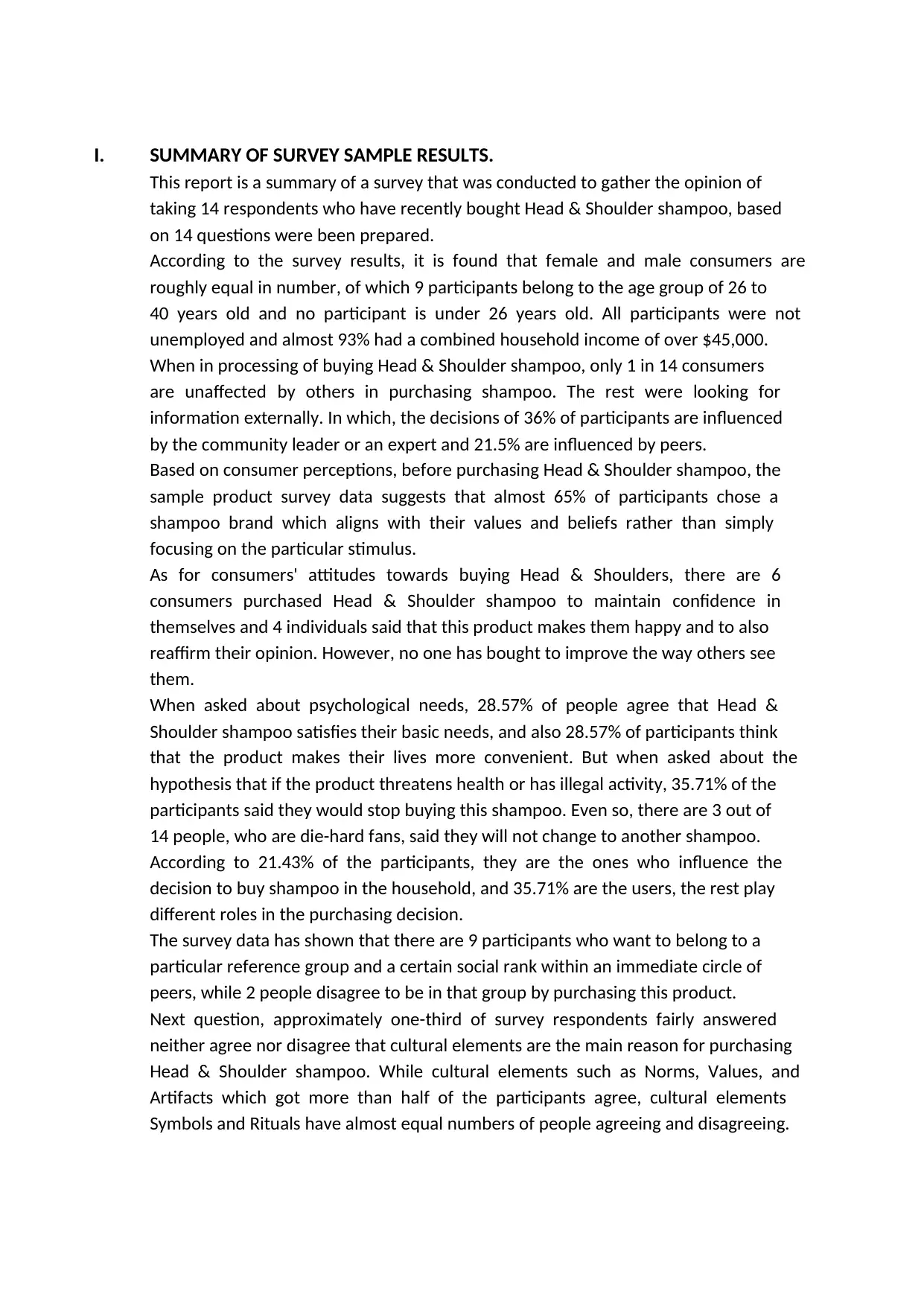
I. SUMMARY OF SURVEY SAMPLE RESULTS.
This report is a summary of a survey that was conducted to gather the opinion of
taking 14 respondents who have recently bought Head & Shoulder shampoo, based
on 14 questions were been prepared.
According to the survey results, it is found that female and male consumers are
roughly equal in number, of which 9 participants belong to the age group of 26 to
40 years old and no participant is under 26 years old. All participants were not
unemployed and almost 93% had a combined household income of over $45,000.
When in processing of buying Head & Shoulder shampoo, only 1 in 14 consumers
are unaffected by others in purchasing shampoo. The rest were looking for
information externally. In which, the decisions of 36% of participants are influenced
by the community leader or an expert and 21.5% are influenced by peers.
Based on consumer perceptions, before purchasing Head & Shoulder shampoo, the
sample product survey data suggests that almost 65% of participants chose a
shampoo brand which aligns with their values and beliefs rather than simply
focusing on the particular stimulus.
As for consumers' attitudes towards buying Head & Shoulders, there are 6
consumers purchased Head & Shoulder shampoo to maintain confidence in
themselves and 4 individuals said that this product makes them happy and to also
reaffirm their opinion. However, no one has bought to improve the way others see
them.
When asked about psychological needs, 28.57% of people agree that Head &
Shoulder shampoo satisfies their basic needs, and also 28.57% of participants think
that the product makes their lives more convenient. But when asked about the
hypothesis that if the product threatens health or has illegal activity, 35.71% of the
participants said they would stop buying this shampoo. Even so, there are 3 out of
14 people, who are die-hard fans, said they will not change to another shampoo.
According to 21.43% of the participants, they are the ones who influence the
decision to buy shampoo in the household, and 35.71% are the users, the rest play
different roles in the purchasing decision.
The survey data has shown that there are 9 participants who want to belong to a
particular reference group and a certain social rank within an immediate circle of
peers, while 2 people disagree to be in that group by purchasing this product.
Next question, approximately one-third of survey respondents fairly answered
neither agree nor disagree that cultural elements are the main reason for purchasing
Head & Shoulder shampoo. While cultural elements such as Norms, Values, and
Artifacts which got more than half of the participants agree, cultural elements
Symbols and Rituals have almost equal numbers of people agreeing and disagreeing.
This report is a summary of a survey that was conducted to gather the opinion of
taking 14 respondents who have recently bought Head & Shoulder shampoo, based
on 14 questions were been prepared.
According to the survey results, it is found that female and male consumers are
roughly equal in number, of which 9 participants belong to the age group of 26 to
40 years old and no participant is under 26 years old. All participants were not
unemployed and almost 93% had a combined household income of over $45,000.
When in processing of buying Head & Shoulder shampoo, only 1 in 14 consumers
are unaffected by others in purchasing shampoo. The rest were looking for
information externally. In which, the decisions of 36% of participants are influenced
by the community leader or an expert and 21.5% are influenced by peers.
Based on consumer perceptions, before purchasing Head & Shoulder shampoo, the
sample product survey data suggests that almost 65% of participants chose a
shampoo brand which aligns with their values and beliefs rather than simply
focusing on the particular stimulus.
As for consumers' attitudes towards buying Head & Shoulders, there are 6
consumers purchased Head & Shoulder shampoo to maintain confidence in
themselves and 4 individuals said that this product makes them happy and to also
reaffirm their opinion. However, no one has bought to improve the way others see
them.
When asked about psychological needs, 28.57% of people agree that Head &
Shoulder shampoo satisfies their basic needs, and also 28.57% of participants think
that the product makes their lives more convenient. But when asked about the
hypothesis that if the product threatens health or has illegal activity, 35.71% of the
participants said they would stop buying this shampoo. Even so, there are 3 out of
14 people, who are die-hard fans, said they will not change to another shampoo.
According to 21.43% of the participants, they are the ones who influence the
decision to buy shampoo in the household, and 35.71% are the users, the rest play
different roles in the purchasing decision.
The survey data has shown that there are 9 participants who want to belong to a
particular reference group and a certain social rank within an immediate circle of
peers, while 2 people disagree to be in that group by purchasing this product.
Next question, approximately one-third of survey respondents fairly answered
neither agree nor disagree that cultural elements are the main reason for purchasing
Head & Shoulder shampoo. While cultural elements such as Norms, Values, and
Artifacts which got more than half of the participants agree, cultural elements
Symbols and Rituals have almost equal numbers of people agreeing and disagreeing.
Paraphrase This Document
Need a fresh take? Get an instant paraphrase of this document with our AI Paraphraser
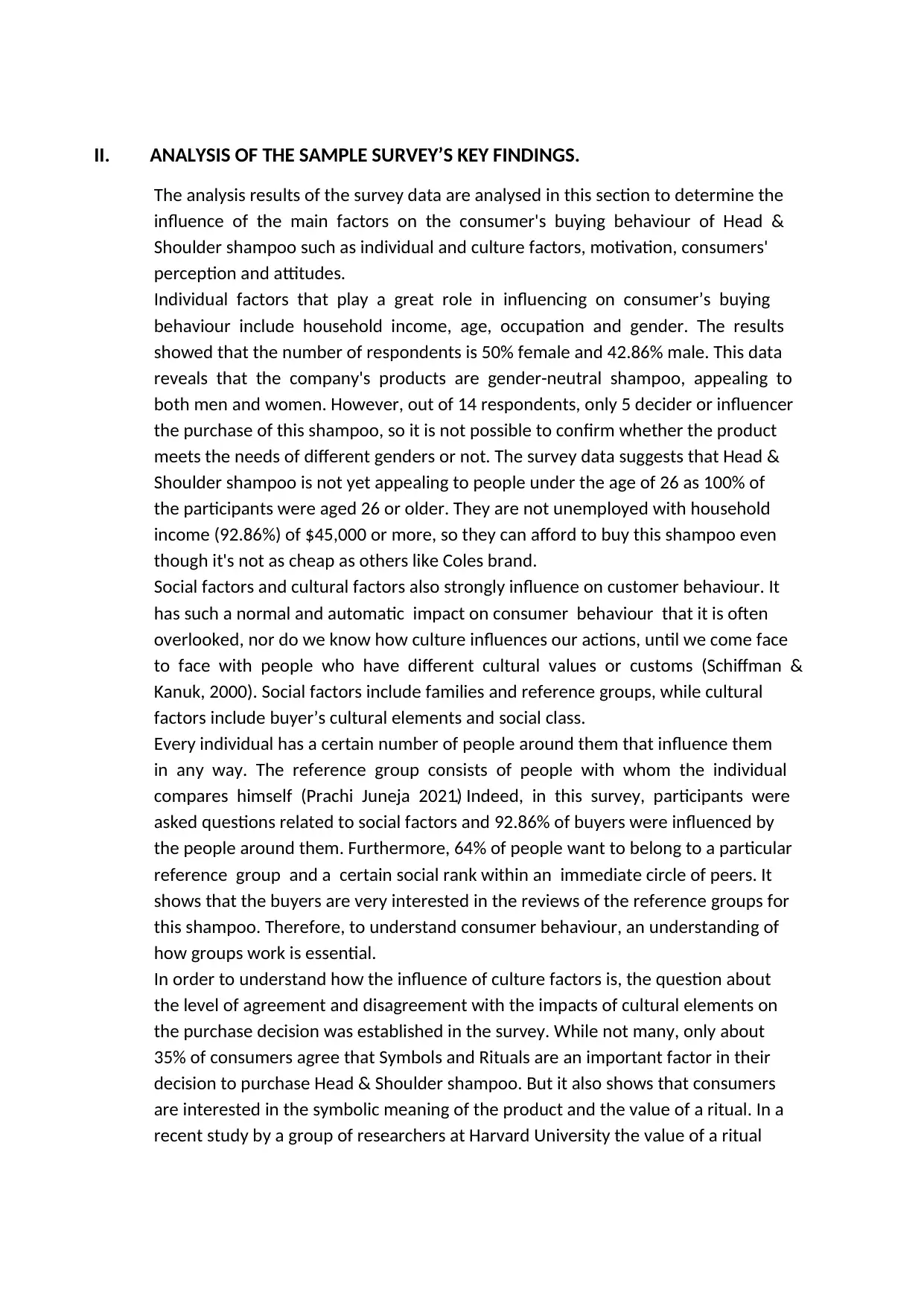
II. ANALYSIS OF THE SAMPLE SURVEY’S KEY FINDINGS.
The analysis results of the survey data are analysed in this section to determine the
influence of the main factors on the consumer's buying behaviour of Head &
Shoulder shampoo such as individual and culture factors, motivation, consumers'
perception and attitudes.
Individual factors that play a great role in influencing on consumer’s buying
behaviour include household income, age, occupation and gender. The results
showed that the number of respondents is 50% female and 42.86% male. This data
reveals that the company's products are gender-neutral shampoo, appealing to
both men and women. However, out of 14 respondents, only 5 decider or influencer
the purchase of this shampoo, so it is not possible to confirm whether the product
meets the needs of different genders or not. The survey data suggests that Head &
Shoulder shampoo is not yet appealing to people under the age of 26 as 100% of
the participants were aged 26 or older. They are not unemployed with household
income (92.86%) of $45,000 or more, so they can afford to buy this shampoo even
though it's not as cheap as others like Coles brand.
Social factors and cultural factors also strongly influence on customer behaviour. It
has such a normal and automatic impact on consumer behaviour that it is often
overlooked, nor do we know how culture influences our actions, until we come face
to face with people who have different cultural values or customs (Schiffman &
Kanuk, 2000). Social factors include families and reference groups, while cultural
factors include buyer’s cultural elements and social class.
Every individual has a certain number of people around them that influence them
in any way. The reference group consists of people with whom the individual
compares himself (Prachi Juneja 2021). Indeed, in this survey, participants were
asked questions related to social factors and 92.86% of buyers were influenced by
the people around them. Furthermore, 64% of people want to belong to a particular
reference group and a certain social rank within an immediate circle of peers. It
shows that the buyers are very interested in the reviews of the reference groups for
this shampoo. Therefore, to understand consumer behaviour, an understanding of
how groups work is essential.
In order to understand how the influence of culture factors is, the question about
the level of agreement and disagreement with the impacts of cultural elements on
the purchase decision was established in the survey. While not many, only about
35% of consumers agree that Symbols and Rituals are an important factor in their
decision to purchase Head & Shoulder shampoo. But it also shows that consumers
are interested in the symbolic meaning of the product and the value of a ritual. In a
recent study by a group of researchers at Harvard University the value of a ritual
The analysis results of the survey data are analysed in this section to determine the
influence of the main factors on the consumer's buying behaviour of Head &
Shoulder shampoo such as individual and culture factors, motivation, consumers'
perception and attitudes.
Individual factors that play a great role in influencing on consumer’s buying
behaviour include household income, age, occupation and gender. The results
showed that the number of respondents is 50% female and 42.86% male. This data
reveals that the company's products are gender-neutral shampoo, appealing to
both men and women. However, out of 14 respondents, only 5 decider or influencer
the purchase of this shampoo, so it is not possible to confirm whether the product
meets the needs of different genders or not. The survey data suggests that Head &
Shoulder shampoo is not yet appealing to people under the age of 26 as 100% of
the participants were aged 26 or older. They are not unemployed with household
income (92.86%) of $45,000 or more, so they can afford to buy this shampoo even
though it's not as cheap as others like Coles brand.
Social factors and cultural factors also strongly influence on customer behaviour. It
has such a normal and automatic impact on consumer behaviour that it is often
overlooked, nor do we know how culture influences our actions, until we come face
to face with people who have different cultural values or customs (Schiffman &
Kanuk, 2000). Social factors include families and reference groups, while cultural
factors include buyer’s cultural elements and social class.
Every individual has a certain number of people around them that influence them
in any way. The reference group consists of people with whom the individual
compares himself (Prachi Juneja 2021). Indeed, in this survey, participants were
asked questions related to social factors and 92.86% of buyers were influenced by
the people around them. Furthermore, 64% of people want to belong to a particular
reference group and a certain social rank within an immediate circle of peers. It
shows that the buyers are very interested in the reviews of the reference groups for
this shampoo. Therefore, to understand consumer behaviour, an understanding of
how groups work is essential.
In order to understand how the influence of culture factors is, the question about
the level of agreement and disagreement with the impacts of cultural elements on
the purchase decision was established in the survey. While not many, only about
35% of consumers agree that Symbols and Rituals are an important factor in their
decision to purchase Head & Shoulder shampoo. But it also shows that consumers
are interested in the symbolic meaning of the product and the value of a ritual. In a
recent study by a group of researchers at Harvard University the value of a ritual
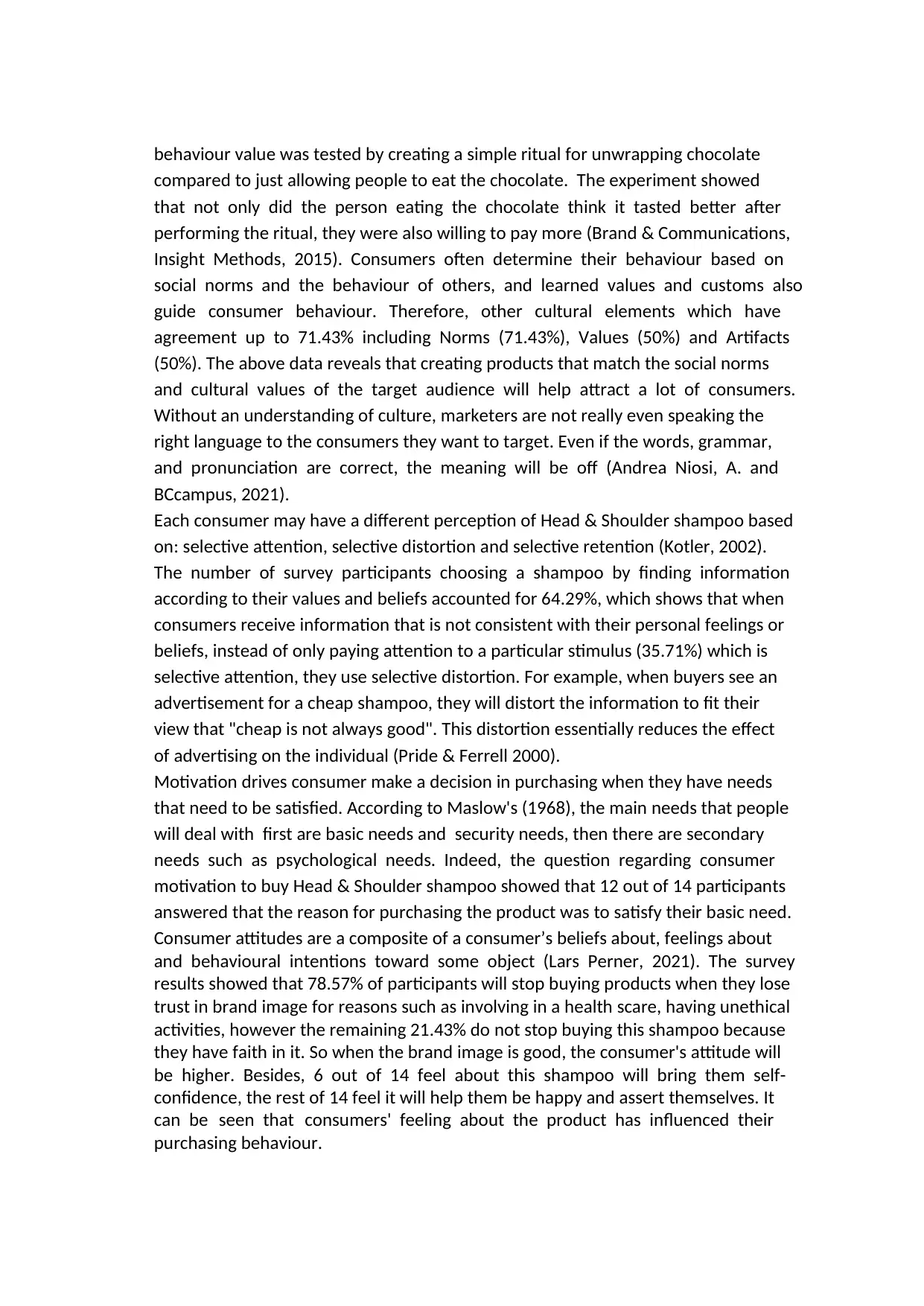
behaviour value was tested by creating a simple ritual for unwrapping chocolate
compared to just allowing people to eat the chocolate. The experiment showed
that not only did the person eating the chocolate think it tasted better after
performing the ritual, they were also willing to pay more (Brand & Communications,
Insight Methods, 2015). Consumers often determine their behaviour based on
social norms and the behaviour of others, and learned values and customs also
guide consumer behaviour. Therefore, other cultural elements which have
agreement up to 71.43% including Norms (71.43%), Values (50%) and Artifacts
(50%). The above data reveals that creating products that match the social norms
and cultural values of the target audience will help attract a lot of consumers.
Without an understanding of culture, marketers are not really even speaking the
right language to the consumers they want to target. Even if the words, grammar,
and pronunciation are correct, the meaning will be off (Andrea Niosi, A. and
BCcampus, 2021).
Each consumer may have a different perception of Head & Shoulder shampoo based
on: selective attention, selective distortion and selective retention (Kotler, 2002).
The number of survey participants choosing a shampoo by finding information
according to their values and beliefs accounted for 64.29%, which shows that when
consumers receive information that is not consistent with their personal feelings or
beliefs, instead of only paying attention to a particular stimulus (35.71%) which is
selective attention, they use selective distortion. For example, when buyers see an
advertisement for a cheap shampoo, they will distort the information to fit their
view that "cheap is not always good". This distortion essentially reduces the effect
of advertising on the individual (Pride & Ferrell 2000).
Motivation drives consumer make a decision in purchasing when they have needs
that need to be satisfied. According to Maslow's (1968), the main needs that people
will deal with first are basic needs and security needs, then there are secondary
needs such as psychological needs. Indeed, the question regarding consumer
motivation to buy Head & Shoulder shampoo showed that 12 out of 14 participants
answered that the reason for purchasing the product was to satisfy their basic need.
Consumer attitudes are a composite of a consumer’s beliefs about, feelings about
and behavioural intentions toward some object (Lars Perner, 2021). The survey
results showed that 78.57% of participants will stop buying products when they lose
trust in brand image for reasons such as involving in a health scare, having unethical
activities, however the remaining 21.43% do not stop buying this shampoo because
they have faith in it. So when the brand image is good, the consumer's attitude will
be higher. Besides, 6 out of 14 feel about this shampoo will bring them self-
confidence, the rest of 14 feel it will help them be happy and assert themselves. It
can be seen that consumers' feeling about the product has influenced their
purchasing behaviour.
compared to just allowing people to eat the chocolate. The experiment showed
that not only did the person eating the chocolate think it tasted better after
performing the ritual, they were also willing to pay more (Brand & Communications,
Insight Methods, 2015). Consumers often determine their behaviour based on
social norms and the behaviour of others, and learned values and customs also
guide consumer behaviour. Therefore, other cultural elements which have
agreement up to 71.43% including Norms (71.43%), Values (50%) and Artifacts
(50%). The above data reveals that creating products that match the social norms
and cultural values of the target audience will help attract a lot of consumers.
Without an understanding of culture, marketers are not really even speaking the
right language to the consumers they want to target. Even if the words, grammar,
and pronunciation are correct, the meaning will be off (Andrea Niosi, A. and
BCcampus, 2021).
Each consumer may have a different perception of Head & Shoulder shampoo based
on: selective attention, selective distortion and selective retention (Kotler, 2002).
The number of survey participants choosing a shampoo by finding information
according to their values and beliefs accounted for 64.29%, which shows that when
consumers receive information that is not consistent with their personal feelings or
beliefs, instead of only paying attention to a particular stimulus (35.71%) which is
selective attention, they use selective distortion. For example, when buyers see an
advertisement for a cheap shampoo, they will distort the information to fit their
view that "cheap is not always good". This distortion essentially reduces the effect
of advertising on the individual (Pride & Ferrell 2000).
Motivation drives consumer make a decision in purchasing when they have needs
that need to be satisfied. According to Maslow's (1968), the main needs that people
will deal with first are basic needs and security needs, then there are secondary
needs such as psychological needs. Indeed, the question regarding consumer
motivation to buy Head & Shoulder shampoo showed that 12 out of 14 participants
answered that the reason for purchasing the product was to satisfy their basic need.
Consumer attitudes are a composite of a consumer’s beliefs about, feelings about
and behavioural intentions toward some object (Lars Perner, 2021). The survey
results showed that 78.57% of participants will stop buying products when they lose
trust in brand image for reasons such as involving in a health scare, having unethical
activities, however the remaining 21.43% do not stop buying this shampoo because
they have faith in it. So when the brand image is good, the consumer's attitude will
be higher. Besides, 6 out of 14 feel about this shampoo will bring them self-
confidence, the rest of 14 feel it will help them be happy and assert themselves. It
can be seen that consumers' feeling about the product has influenced their
purchasing behaviour.
⊘ This is a preview!⊘
Do you want full access?
Subscribe today to unlock all pages.

Trusted by 1+ million students worldwide
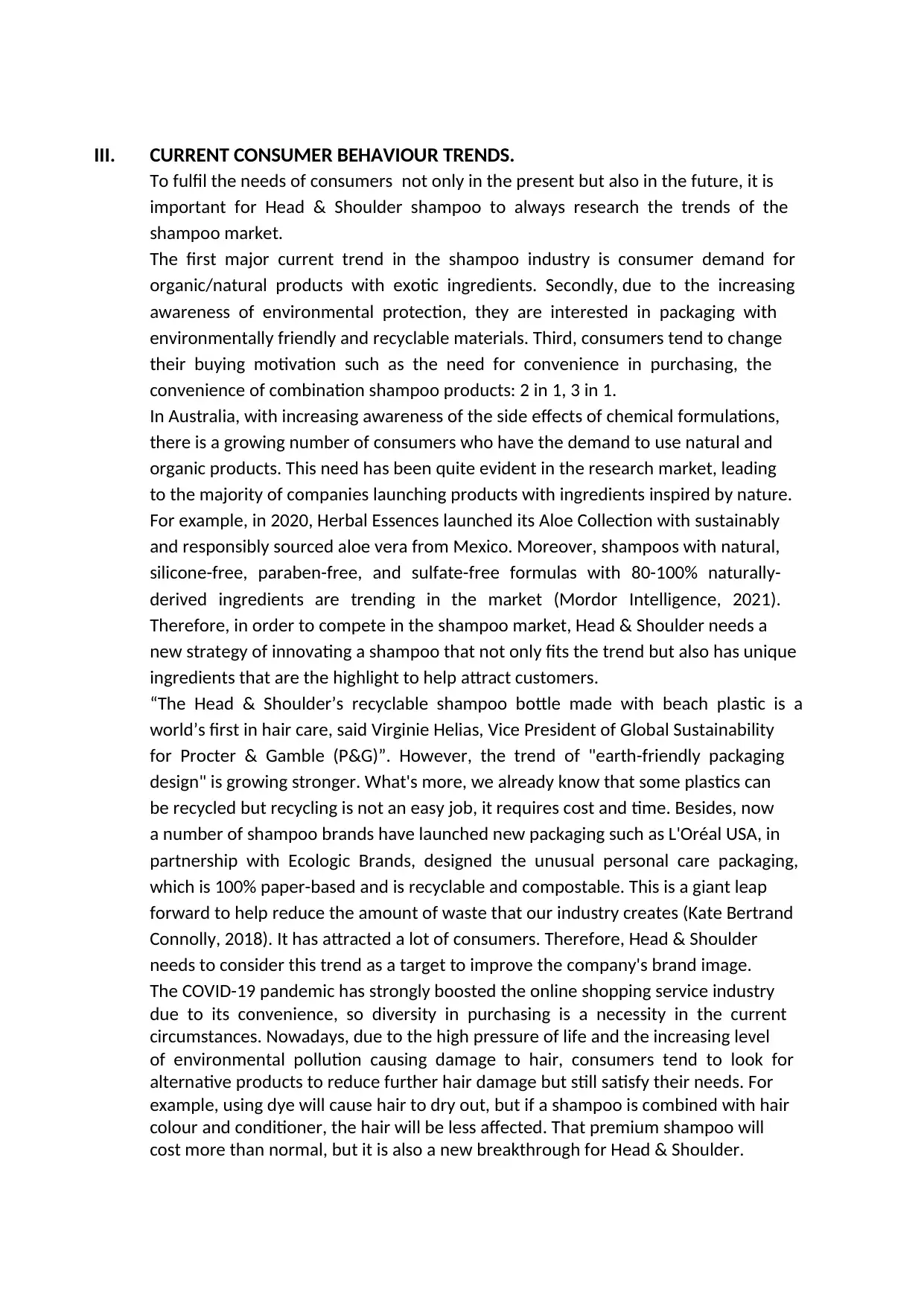
III. CURRENT CONSUMER BEHAVIOUR TRENDS.
To fulfil the needs of consumers not only in the present but also in the future, it is
important for Head & Shoulder shampoo to always research the trends of the
shampoo market.
The first major current trend in the shampoo industry is consumer demand for
organic/natural products with exotic ingredients. Secondly, due to the increasing
awareness of environmental protection, they are interested in packaging with
environmentally friendly and recyclable materials. Third, consumers tend to change
their buying motivation such as the need for convenience in purchasing, the
convenience of combination shampoo products: 2 in 1, 3 in 1.
In Australia, with increasing awareness of the side effects of chemical formulations,
there is a growing number of consumers who have the demand to use natural and
organic products. This need has been quite evident in the research market, leading
to the majority of companies launching products with ingredients inspired by nature.
For example, in 2020, Herbal Essences launched its Aloe Collection with sustainably
and responsibly sourced aloe vera from Mexico. Moreover, shampoos with natural,
silicone-free, paraben-free, and sulfate-free formulas with 80-100% naturally-
derived ingredients are trending in the market (Mordor Intelligence, 2021).
Therefore, in order to compete in the shampoo market, Head & Shoulder needs a
new strategy of innovating a shampoo that not only fits the trend but also has unique
ingredients that are the highlight to help attract customers.
“The Head & Shoulder’s recyclable shampoo bottle made with beach plastic is a
world’s first in hair care, said Virginie Helias, Vice President of Global Sustainability
for Procter & Gamble (P&G)”. However, the trend of "earth-friendly packaging
design" is growing stronger. What's more, we already know that some plastics can
be recycled but recycling is not an easy job, it requires cost and time. Besides, now
a number of shampoo brands have launched new packaging such as L'Oréal USA, in
partnership with Ecologic Brands, designed the unusual personal care packaging,
which is 100% paper-based and is recyclable and compostable. This is a giant leap
forward to help reduce the amount of waste that our industry creates (Kate Bertrand
Connolly, 2018). It has attracted a lot of consumers. Therefore, Head & Shoulder
needs to consider this trend as a target to improve the company's brand image.
The COVID-19 pandemic has strongly boosted the online shopping service industry
due to its convenience, so diversity in purchasing is a necessity in the current
circumstances. Nowadays, due to the high pressure of life and the increasing level
of environmental pollution causing damage to hair, consumers tend to look for
alternative products to reduce further hair damage but still satisfy their needs. For
example, using dye will cause hair to dry out, but if a shampoo is combined with hair
colour and conditioner, the hair will be less affected. That premium shampoo will
cost more than normal, but it is also a new breakthrough for Head & Shoulder.
To fulfil the needs of consumers not only in the present but also in the future, it is
important for Head & Shoulder shampoo to always research the trends of the
shampoo market.
The first major current trend in the shampoo industry is consumer demand for
organic/natural products with exotic ingredients. Secondly, due to the increasing
awareness of environmental protection, they are interested in packaging with
environmentally friendly and recyclable materials. Third, consumers tend to change
their buying motivation such as the need for convenience in purchasing, the
convenience of combination shampoo products: 2 in 1, 3 in 1.
In Australia, with increasing awareness of the side effects of chemical formulations,
there is a growing number of consumers who have the demand to use natural and
organic products. This need has been quite evident in the research market, leading
to the majority of companies launching products with ingredients inspired by nature.
For example, in 2020, Herbal Essences launched its Aloe Collection with sustainably
and responsibly sourced aloe vera from Mexico. Moreover, shampoos with natural,
silicone-free, paraben-free, and sulfate-free formulas with 80-100% naturally-
derived ingredients are trending in the market (Mordor Intelligence, 2021).
Therefore, in order to compete in the shampoo market, Head & Shoulder needs a
new strategy of innovating a shampoo that not only fits the trend but also has unique
ingredients that are the highlight to help attract customers.
“The Head & Shoulder’s recyclable shampoo bottle made with beach plastic is a
world’s first in hair care, said Virginie Helias, Vice President of Global Sustainability
for Procter & Gamble (P&G)”. However, the trend of "earth-friendly packaging
design" is growing stronger. What's more, we already know that some plastics can
be recycled but recycling is not an easy job, it requires cost and time. Besides, now
a number of shampoo brands have launched new packaging such as L'Oréal USA, in
partnership with Ecologic Brands, designed the unusual personal care packaging,
which is 100% paper-based and is recyclable and compostable. This is a giant leap
forward to help reduce the amount of waste that our industry creates (Kate Bertrand
Connolly, 2018). It has attracted a lot of consumers. Therefore, Head & Shoulder
needs to consider this trend as a target to improve the company's brand image.
The COVID-19 pandemic has strongly boosted the online shopping service industry
due to its convenience, so diversity in purchasing is a necessity in the current
circumstances. Nowadays, due to the high pressure of life and the increasing level
of environmental pollution causing damage to hair, consumers tend to look for
alternative products to reduce further hair damage but still satisfy their needs. For
example, using dye will cause hair to dry out, but if a shampoo is combined with hair
colour and conditioner, the hair will be less affected. That premium shampoo will
cost more than normal, but it is also a new breakthrough for Head & Shoulder.
Paraphrase This Document
Need a fresh take? Get an instant paraphrase of this document with our AI Paraphraser
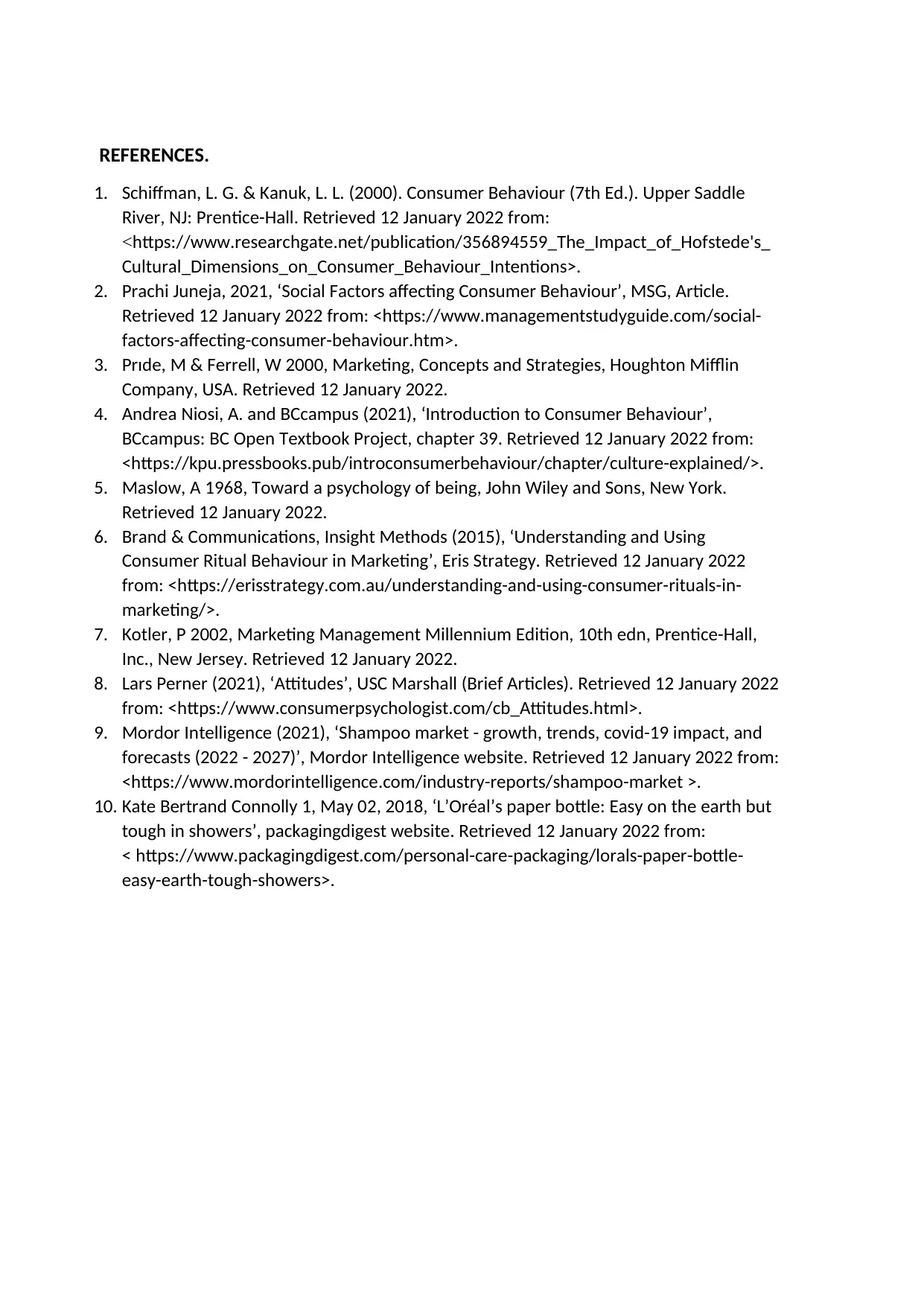
REFERENCES.
1. Schiffman, L. G. & Kanuk, L. L. (2000). Consumer Behaviour (7th Ed.). Upper Saddle
River, NJ: Prentice-Hall. Retrieved 12 January 2022 from:
<https://www.researchgate.net/publication/356894559_The_Impact_of_Hofstede's_
Cultural_Dimensions_on_Consumer_Behaviour_Intentions>.
2. Prachi Juneja, 2021, ‘Social Factors affecting Consumer Behaviour’, MSG, Article.
Retrieved 12 January 2022 from: <https://www.managementstudyguide.com/social-
factors-affecting-consumer-behaviour.htm>.
3. Prıde, M & Ferrell, W 2000, Marketing, Concepts and Strategies, Houghton Mifflin
Company, USA. Retrieved 12 January 2022.
4. Andrea Niosi, A. and BCcampus (2021), ‘Introduction to Consumer Behaviour’,
BCcampus: BC Open Textbook Project, chapter 39. Retrieved 12 January 2022 from:
<https://kpu.pressbooks.pub/introconsumerbehaviour/chapter/culture-explained/>.
5. Maslow, A 1968, Toward a psychology of being, John Wiley and Sons, New York.
Retrieved 12 January 2022.
6. Brand & Communications, Insight Methods (2015), ‘Understanding and Using
Consumer Ritual Behaviour in Marketing’, Eris Strategy. Retrieved 12 January 2022
from: <https://erisstrategy.com.au/understanding-and-using-consumer-rituals-in-
marketing/>.
7. Kotler, P 2002, Marketing Management Millennium Edition, 10th edn, Prentice-Hall,
Inc., New Jersey. Retrieved 12 January 2022.
8. Lars Perner (2021), ‘Attitudes’, USC Marshall (Brief Articles). Retrieved 12 January 2022
from: <https://www.consumerpsychologist.com/cb_Attitudes.html>.
9. Mordor Intelligence (2021), ‘Shampoo market - growth, trends, covid-19 impact, and
forecasts (2022 - 2027)’, Mordor Intelligence website. Retrieved 12 January 2022 from:
<https://www.mordorintelligence.com/industry-reports/shampoo-market >.
10. Kate Bertrand Connolly 1, May 02, 2018, ‘L’Oréal’s paper bottle: Easy on the earth but
tough in showers’, packagingdigest website. Retrieved 12 January 2022 from:
< https://www.packagingdigest.com/personal-care-packaging/lorals-paper-bottle-
easy-earth-tough-showers>.
1. Schiffman, L. G. & Kanuk, L. L. (2000). Consumer Behaviour (7th Ed.). Upper Saddle
River, NJ: Prentice-Hall. Retrieved 12 January 2022 from:
<https://www.researchgate.net/publication/356894559_The_Impact_of_Hofstede's_
Cultural_Dimensions_on_Consumer_Behaviour_Intentions>.
2. Prachi Juneja, 2021, ‘Social Factors affecting Consumer Behaviour’, MSG, Article.
Retrieved 12 January 2022 from: <https://www.managementstudyguide.com/social-
factors-affecting-consumer-behaviour.htm>.
3. Prıde, M & Ferrell, W 2000, Marketing, Concepts and Strategies, Houghton Mifflin
Company, USA. Retrieved 12 January 2022.
4. Andrea Niosi, A. and BCcampus (2021), ‘Introduction to Consumer Behaviour’,
BCcampus: BC Open Textbook Project, chapter 39. Retrieved 12 January 2022 from:
<https://kpu.pressbooks.pub/introconsumerbehaviour/chapter/culture-explained/>.
5. Maslow, A 1968, Toward a psychology of being, John Wiley and Sons, New York.
Retrieved 12 January 2022.
6. Brand & Communications, Insight Methods (2015), ‘Understanding and Using
Consumer Ritual Behaviour in Marketing’, Eris Strategy. Retrieved 12 January 2022
from: <https://erisstrategy.com.au/understanding-and-using-consumer-rituals-in-
marketing/>.
7. Kotler, P 2002, Marketing Management Millennium Edition, 10th edn, Prentice-Hall,
Inc., New Jersey. Retrieved 12 January 2022.
8. Lars Perner (2021), ‘Attitudes’, USC Marshall (Brief Articles). Retrieved 12 January 2022
from: <https://www.consumerpsychologist.com/cb_Attitudes.html>.
9. Mordor Intelligence (2021), ‘Shampoo market - growth, trends, covid-19 impact, and
forecasts (2022 - 2027)’, Mordor Intelligence website. Retrieved 12 January 2022 from:
<https://www.mordorintelligence.com/industry-reports/shampoo-market >.
10. Kate Bertrand Connolly 1, May 02, 2018, ‘L’Oréal’s paper bottle: Easy on the earth but
tough in showers’, packagingdigest website. Retrieved 12 January 2022 from:
< https://www.packagingdigest.com/personal-care-packaging/lorals-paper-bottle-
easy-earth-tough-showers>.

⊘ This is a preview!⊘
Do you want full access?
Subscribe today to unlock all pages.

Trusted by 1+ million students worldwide
1 out of 6
Your All-in-One AI-Powered Toolkit for Academic Success.
+13062052269
info@desklib.com
Available 24*7 on WhatsApp / Email
![[object Object]](/_next/static/media/star-bottom.7253800d.svg)
Unlock your academic potential
Copyright © 2020–2025 A2Z Services. All Rights Reserved. Developed and managed by ZUCOL.


